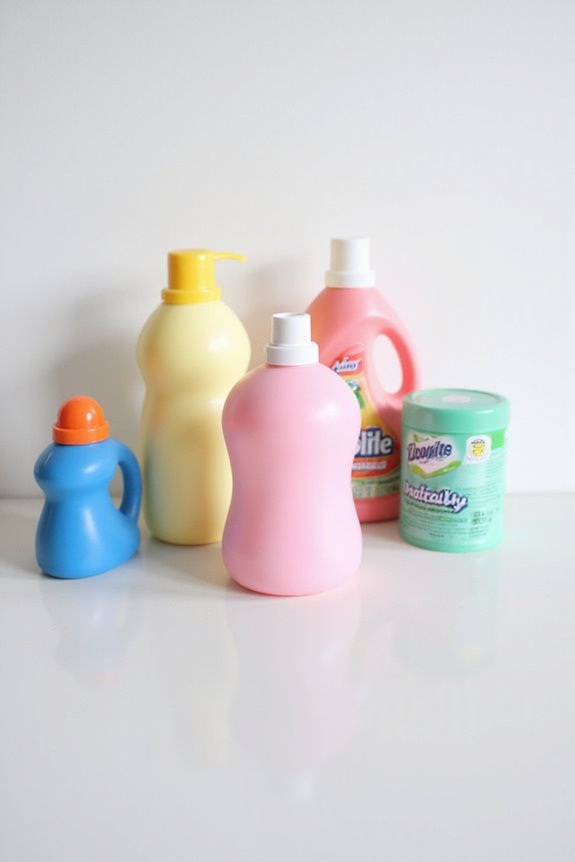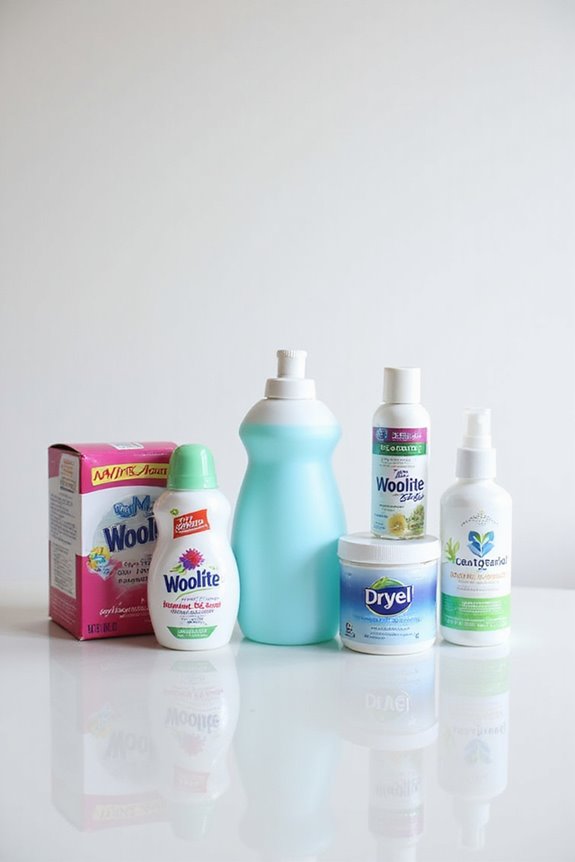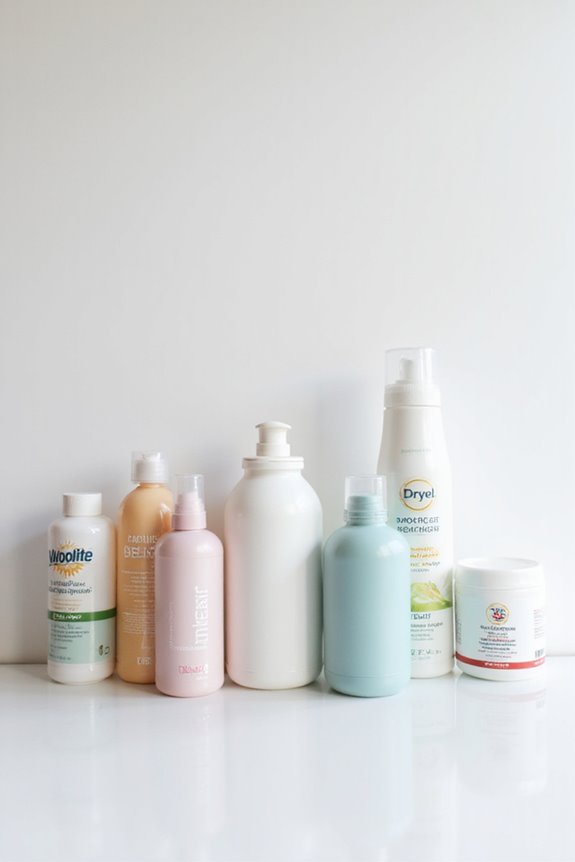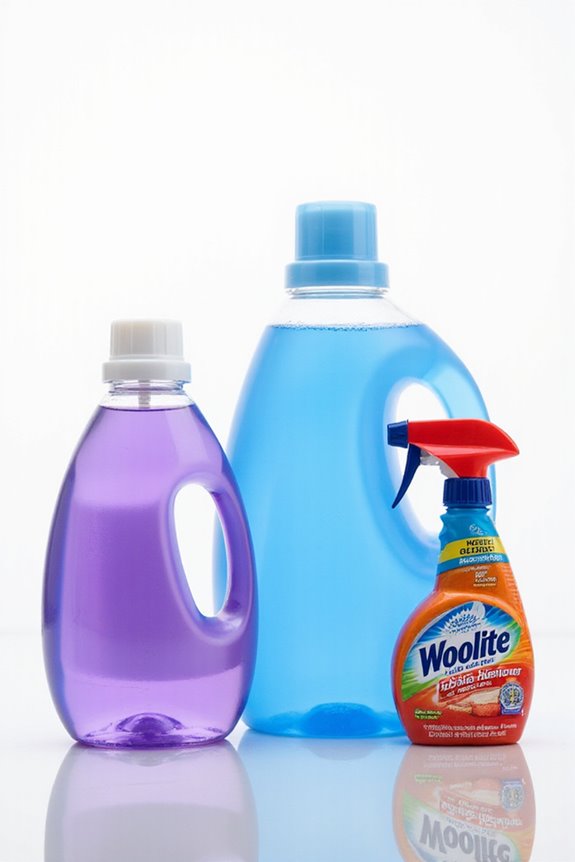To make fabric softeners last longer, let’s start by measuring the right amount according to the instructions on the bottle. We should also store them in cool places, away from heat and light, to keep their effectiveness. Regularly cleaning our washing machines avoids buildup that can waste product too. And hey, if we have some natural options, like vinegar or baking soda, they can be great alternatives. Stick around, and we’ll uncover even more helpful tips!
Key Takeaways
- Measure and use the recommended dosage of fabric softener to avoid waste and prolong supply.
- Dilute fabric softener with water for even distribution and to minimize buildup on fabrics.
- Store fabric softeners in cool, dry places away from heat and humidity to maintain effectiveness.
- Regularly clean your washing machine to prevent residue buildup that can waste softener.
- Consider eco-friendly alternatives like vinegar or baking soda to achieve softening effects without relying solely on commercial products.
Optimize Usage Amount
When it comes to making our fabric softeners last longer, one of the first things we should do is optimize the amount we use. Let’s start by measuring the fabric softener dosage correctly. Following the manufacturer’s guidelines for load size adjustment is key. Using the fill lines on caps helps us avoid overuse, which can leave residue on our clothes. We’ve learned that adding a little more softener for larger, heavily soiled loads can improve performance, but guesswork only leads to waste. Trust us, excess softener doesn’t mean extra softness. It can actually shorten our supply! By measuring accurately, we can keep our fabric softeners around longer while still enjoying their lovely scents and softness. Additionally, using a small amount of concentrated softener can ensure you get the most out of each bottle. Who knew saving could smell so good?
Choose the Right Type
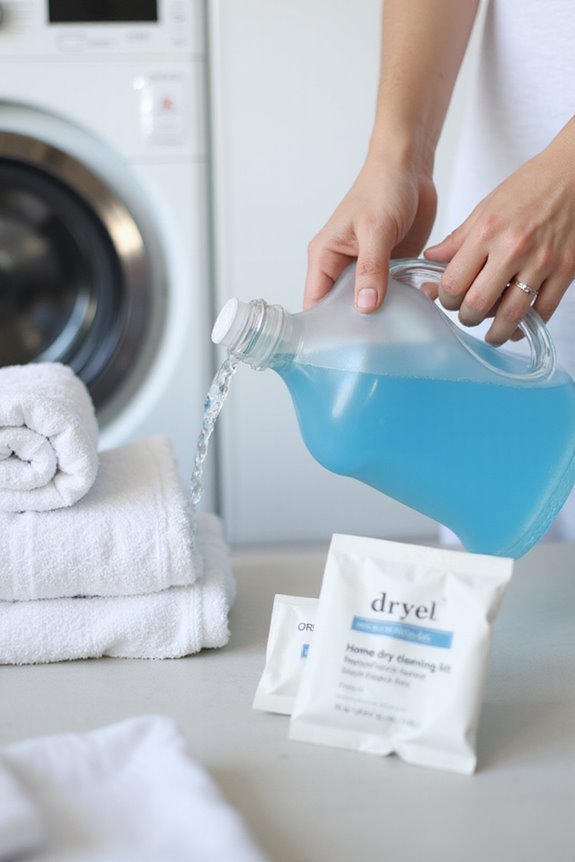
Choosing the right type of fabric softener can make a world of difference in how our clothes feel and smell. Liquid fabric softeners are great for various fabric types, coating fibers evenly during the rinse cycle. We’ve found they prevent piling too! Dryer sheets are super convenient but can leave residue, which might not be ideal for all fabrics. For those of us with sensitive skin or allergies, dryer balls are a good option. They help reduce static without chemicals. Remember, some fabrics, like athletic wear or microfiber, can be compromised by traditional softeners, so softener compatibility is key. Always check care labels to keep our favorite clothes in great shape! Additionally, selecting hypoallergenic products can further enhance the comfort of delicate fabrics.
Store Properly
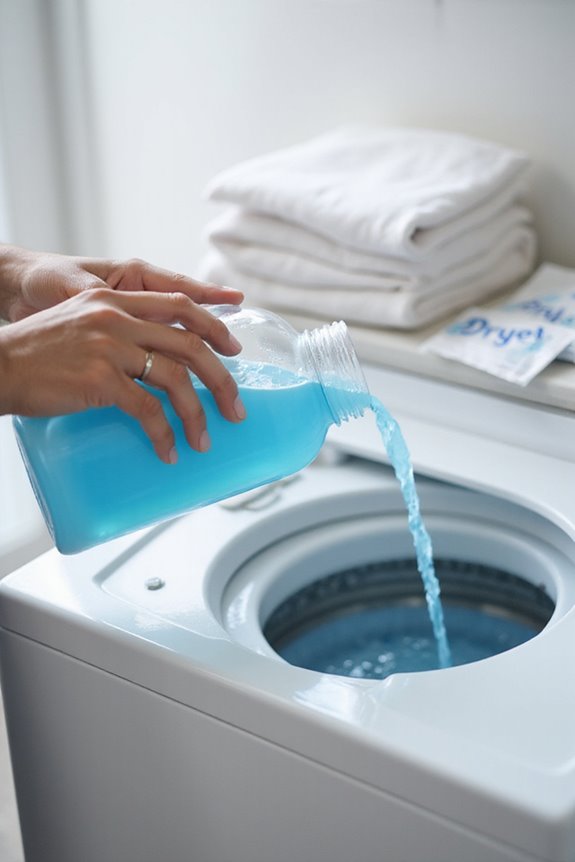
Now that we’ve picked the right type of fabric softener, it’s time to talk about how to store it properly. First, we should keep our softeners in cool, dry areas. Heat and humidity can really spoil them! Avoid spots with direct sunlight too, as that breaks down the good stuff.
We can use airtight containers to prevent spills and keep moisture out. Plus, labeling them helps us remember what’s inside.
It’s super important to store these out of reach from kids and pets, just to be safe.
Lastly, let’s think about using smaller quantities for daily use. This way, we limit exposure to air and keep our main stash fresh. With these storage solutions, we’ll make our fabric softeners last longer! Additionally, using hypoallergenic options can help ensure that we are reducing irritants and allergens in our laundry.
Maintain Washing Machine
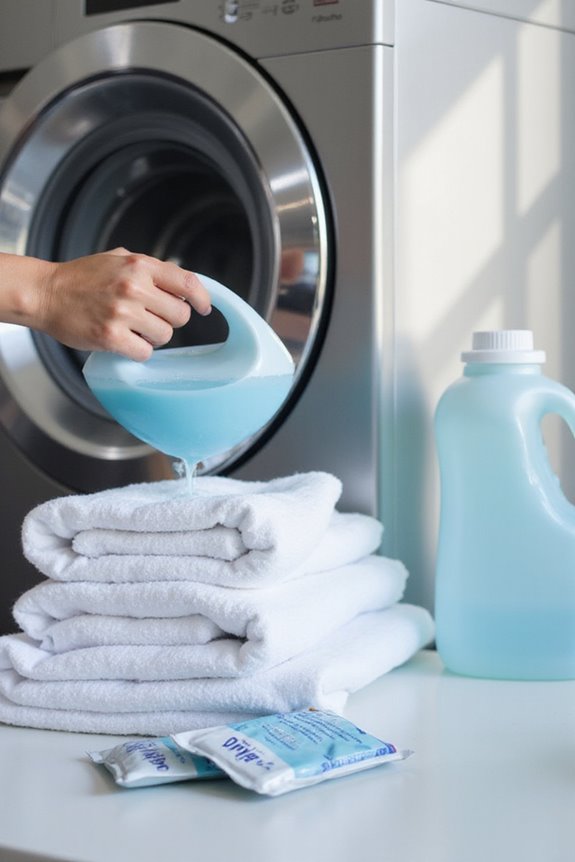
To keep our washing machine running smoothly, we need to pay attention to how fabric softeners can affect it. Over time, fabric softener can leave behind a waxy residue. This buildup can clog dispensers and internal parts, making our machines less efficient. Trust me, we don’t want to deal with unexpected maintenance calls! Regular machine cleaning is essential. We can use vinegar or specialized cleaners to help with residue removal. It’s also a good idea to check dispensers and filters often. If we educate ourselves and our roommates about using fabric softeners wisely, we can extend our machine’s lifespan and avoid costly repairs. Using washing machine cleaner tablets regularly can further enhance the cleanliness and efficiency of our machines. So, let’s keep our washers happy and free of goo!
Apply Fabric Softener Correctly
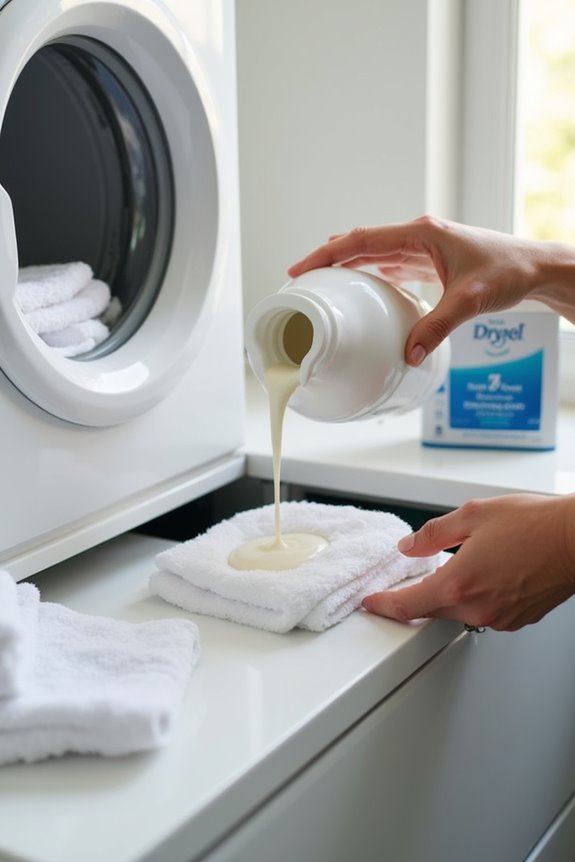
When we think about fabric softeners, it’s easy to overlook how we apply them, but doing it right makes a big difference! First, we should always add fabric softener during the rinse cycle. This rinse cycle timing is key for the best results. If our machine has a dispenser, let it do the work for us. If not, we can pour it directly into the water, not on the clothes, to avoid spots.
Using proper fabric softener techniques, like diluting it with water, helps distribute it evenly. And hey, don’t go overboard! More softener doesn’t mean softer clothes—it can lead to buildup. So, let’s keep it balanced, and our fabrics will thank us for it! Additionally, selecting the right fabric softener sheets can enhance the effectiveness of the application process.
Consider Alternatives and Limits
We’ve covered how to apply fabric softener correctly, but there’s a whole world of alternatives and limits we should consider. First up, wool dryer balls are fantastic! They naturally soften fabrics and cut down on static without any harsh chemicals. We can also use white vinegar—it’s a game-changer for neutralizing odors and preventing scale buildup. Plus, baking soda works wonders for softening and revitalizing colors during the wash. Additionally, many plant-based fabric softeners, such as those made from biodegradable ingredients, provide an eco-friendly option for softer laundry.
But let’s remember, not all alternatives are perfect. For instance, essential oils add great scent but don’t really soften fabrics much, and they can even corrode our washing machines if we’re not careful. By being mindful of these factors, we can improve fabric properties while minimizing our environmental impact.
Understand Water Hardness
Understanding water hardness is essential for getting the most out of our laundry routine. Hard water, with its calcium and magnesium ions, can really mess with our detergent interaction. It reduces foam stability, making our laundry less effective. When we wash clothes in hard water, we might notice they feel stiff and scratchy, not exactly what we want.
Plus, fabric softeners struggle to work their magic in these conditions. They can’t soften fabrics as effectively when these pesky minerals are around. We’ve all experienced that annoying white residue on our clothes, right? By being aware of water hardness, we can find solutions, like using water softeners, to help our detergent and softeners do their jobs better. Let’s tackle those laundry woes together!
Monitor Expiration Dates
After tackling the challenges of hard water, let’s talk about something that can sneak up on us: expiration dates on our fabric softeners. We often forget to keep track, but expiration tracking is essential for effective laundry days. Most unopened fabric softeners last 2-3 years, while opened ones typically stay fresh for 6 months to a year.
Label reading is our best friend here! We should check for signs of age—like clumping or funky smells—before using them. It’s wise to jot down the opening date to avoid surprises later. If we notice any odd changes, it’s better to let that expired softener go. Keeping an eye on these dates can save us from laundry disasters!
Avoid Overuse on Specific Fabrics
When it comes to using fabric softener, we need to be careful about what fabrics we’re treating. Certain fabric types, like sportswear and elastane blends, can lose their stretch or moisture-wicking abilities when we overdo it. We’ve all felt the disappointment when our favorite workout clothes become stiff!
Towels and delicate fibers like wool can also suffer, becoming less absorbent or losing their texture. Plus, using too much softener can create a waxy buildup, which clogs our washing machines. So, let’s stick to using fabric softener sparingly, especially on items that have fabric sensitivities. Always check care labels and remember, less is often more when it comes to keeping our clothes comfy and safe!
Utilize Natural Softening Methods
If we want our laundry to feel soft and smell fresh without relying on commercial fabric softeners, there are plenty of natural methods we can try. One favorite is using white vinegar, which breaks down detergent residues and leaves no lingering odors. We can mix 2 cups of vinegar with 20-30 drops of essential oils—think lavender or lemon—for that lovely scent.
Another option is baking soda, which balances pH levels and softens fabrics. A simple mix of 1 cup of baking soda and distilled water can do wonders. Finally, soap nuts are fantastic eco-friendly options that gently soften without chemicals. They’re biodegradable and support sustainability, making our laundry routines both effective and kind to the planet!
Frequently Asked Questions
Can I Mix Different Brands of Fabric Softener?
Absolutely, we can mix different fabric softener brands, just be mindful of brand compatibility and mixing ratios. Using proportional amounts helps maintain softness while avoiding residue, ensuring our fabrics stay fresh and clean.
How Can I Tell if My Softener Is Expired?
Like a forgotten snack, our fabric softener can spoil too. We should watch for expiration indicators—clumps, foul odors, or discoloration—since understanding softener lifespan helps us keep our laundry fresh and effective.
Are There Specific Signs of Fabric Softener Buildup?
We can spot buildup indicators like greasy spots or stiff fabrics on our laundry. To tackle this, we should use removal techniques like cleaning our washer and adjusting softener usage for better results.
Does Fabric Softener Affect Dryer Performance?
We’ve noticed that softener residue seriously stifles dryer efficiency. This sticky buildup not only hampers airflow but also hinders heat, leading to longer drying times and potential damage. It’s best to explore alternatives for peak performance.
Can I Use Fabric Softener in Cold Water Washes?
Absolutely, we can use fabric softener in cold water washes! Its effectiveness shines through, even in cold cycles, and it’s compatible with our washing machines, ensuring our fabrics stay soft and damage-free.

